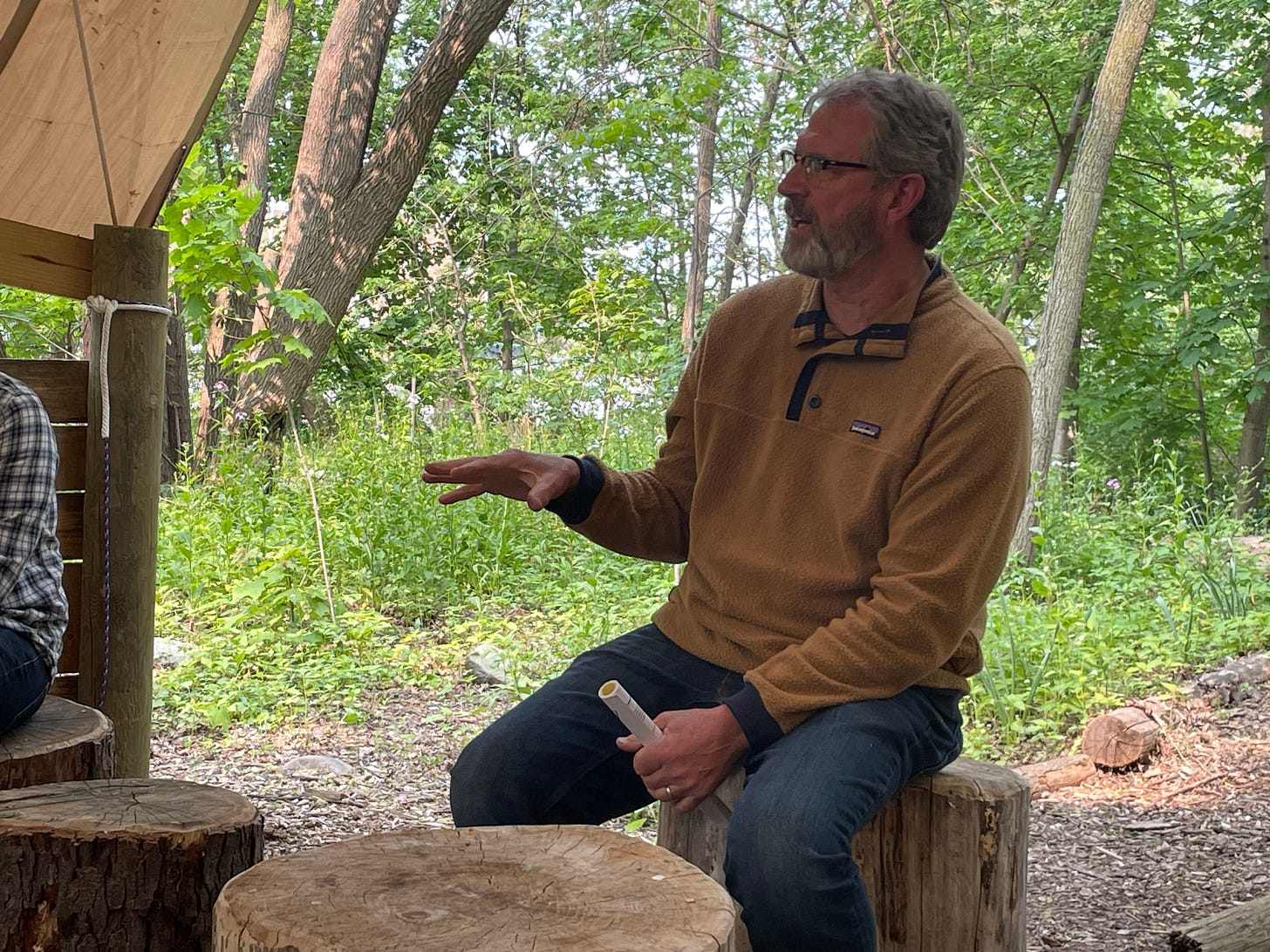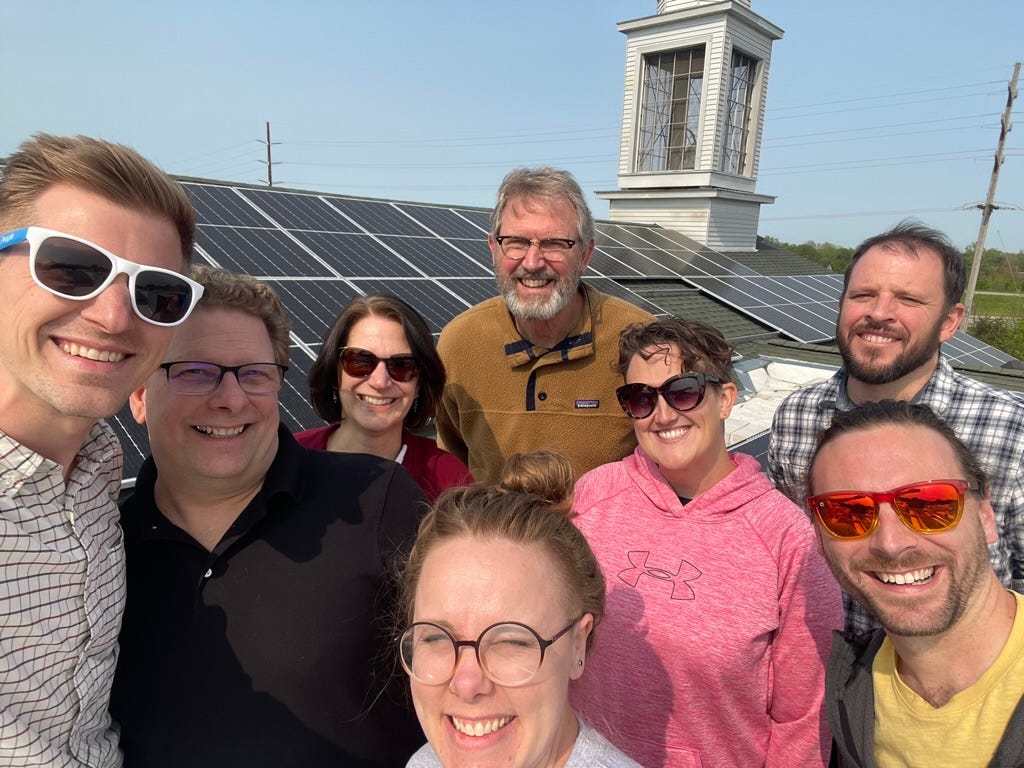Refugia Newsletter #41
Environmental justice update, a church called The Refuge, and biblical trees
Refugia News
I’m just coming off a wonderful week with the Refugia Church Cohort—seven doctoral students I’m directing with husband Ron through Western Theological Seminary. We are seeking together what it could mean for churches and faith groups to lean into that refugia model. Such a rich and beautiful week! You can read a bit more about our adventures below in the Sightings section.
Wonderful people. It’s an honor to work with them.
Next, I’m about to dig into a ridiculously ambitious summer reading list. Most of it, no surprise, is ecotheology and ecoliterature. I’ll also be revising a conference paper I delivered last summer on the sixteenth-century poet George Herbert. I basically wrote a whole scholarly paper on one stanza of “Affliction” (I), a poem in which the speaker recounts his various afflictions, tries to figure out what it all means, and reaches a kind of existential impasse:
Now I am here, what thou wilt do with me
None of my books will show;
I read, and sigh, and wish I were a tree,
For sure then I should grow
To fruit or shade: at least some bird would trust
Her household to me, and I should be just.
My paper attempts to answer the question: why would Herbert’s speaker wish he were a tree? Turns out the answer is complicated and fun. The stuff scholars think about!
This Week in Climate News/Deeper Dive
Since I’ve been hanging out with pastor/scholars all week, I’m behind in my latest-climate-news reading. So we’ll combine our usual News and Deeper-Dive features, and I’ll reach into my fodder file to work on this question: How are we doing on environmental justice?
Short answer: making progress. Maybe. The Biden administration recently released details on a comprehensive executive order called Revitalizing Our Nation’s Commitment to Environmental Justice for All. The idea was to create “an executive order further embedding environmental justice into the work of federal agencies to achieve real, measurable progress that communities can count on.”
The White House Fact Sheet explains:
The Executive Order is part of the Biden-Harris Administration’s whole-of-government effort to confront longstanding environmental injustices and inequities. For far too long, communities across our country have faced persistent environmental injustice through toxic pollution, underinvestment in infrastructure and critical services, and other disproportionate environmental harms often due to a legacy of racial discrimination including redlining. These communities with environmental justice concerns face even greater burdens due to climate change.
Part of where the rubber hits the road on this one is—as usual—where the money goes. Hence the “Justice40 Initiative”:
Through the Justice40 Initiative, the Biden-Harris Administration is reshaping hundreds of federal programs to ensure that 40 percent of the overall benefits of certain federal investments flow to disadvantaged communities.
This includes the landmark Inflation Reduction Act and the dollars made available there, anywhere between $47 and $60 billion, depending on how you figure it. Of course, the question is: will it work? Lots of measures and goals and evaluative tools are built in, but will the money go where it’s supposed to go, do what it’s supposed to do?
Those are questions explored in this January article from Inside Climate News, which outlines six big areas where we are likely to see the implications of White House environmental justice policy play out. How will we negotiate permitting reform, clean energy infrastructure siting, job training, land use disputes, and so on?
One specific fight is over the $27 billion set aside for the Greenhouse Gas Reduction Act, part of the IRA meant to deliver money to disadvantaged communities to build green energy infrastructure. This is exactly the sort of initiative congressional Republicans threaten to strip out of the IRA as “wasteful.” Assuming the debt-ceiling debacle doesn’t blow it all up, we still face the challenge of building “movement infrastructure.”
I learned that term from this very interesting, very wonky episode of the podcast Volts. The episode is called “Building a Movement that Can Take Full Advantage of the IRA.” The White House has established offices to provide technical assistance to state and local groups trying to figure out what projects qualify and so on. But the challenge is to build skills and capacities within disadvantaged communities to actually reach out and capture the available monies. The big environmental groups know how to access grants and leverage funding sources, but what about the small, more local, less experienced groups?
For another in-the-weeds look at this challenge, I recommend the episode called “The Journey of Justice40” from A Matter of Degrees podcast. I can’t say that I understand all the details of how connections get made between federal funds and actual, on-the-ground projects, especially when the goal is to address environmental injustice in the process. But I am impressed and encouraged that lots of people out there are working knowledgeably and diligently in that very complex space.
For a more global perspective on climate justice, here’s a concise interview with environmental author Naomi Klein in The Guardian. Check out the cool videos, too.
Finally, let’s put this whole struggle in the grim perspective of fossil fuel power. Here’s a graphic from the Heated newsletter from May 9. What more can we say?
Refugia Sighting
For anyone wondering what the refugia model looks like when applied to a regular old traditional congregation, my friend Rev. Gerry Koning can tell some stories. I interviewed Gerry for the Refugia Podcast almost two years ago. This week, Ron and I took our D.Min. cohort to visit the church and talk with Gerry.
Refuge Church used to be Trinity Christian Reformed Church in Grandville, Michigan. As a congregation, they slowly transformed their whole model of ministry from the standard growth model to a tri-part focus: including people with disabilities, helping refugees in the community, and integrating creation care into their entire faith formation practice.
They’re a smaller church now—not everyone in the original congregation wanted to move from a traditional model. But the remaining core people are vitally involved in their community and deeply connected to the land and water in their vicinity.
Rev. Gerry Koning demonstrating Refuge Church’s outdoor classroom.
Their large church facility is host to numerous community groups during the week. Sunday school meets outside year round in their outdoor classroom. Kids engage with a creation-focused curriculum. The youth group helps with macroinvertebrate studies in the creek on their property (we learned quite a bit about mussels during our visit). The church partners with a thriving sister church of East African refugees and immigrants, whose pastor lives in church’s parsonage. An unhoused couple are living in a van in a shady corner of the church’s huge parking lot. There’s more—you can check out their website.
Refuge Church is also in the middle of a major solar project that will easily meet their energy needs as well as provide extra for the community. Our group climbed up on their roof to admire the system.
Solar panels and steeples: a great combination.
Refuge Chruch, you might say, is a refugia church thriving in the husk of empire. Our group found great inspiration in Gerry’s humble leadership and intrepid spirit as well as in the congregation’s willingness to go for it and try something different.
The Wayback Machine
How did we get through those early, awful months of quarantine during the pandemic in 2020? Well, some of us came up with nutty little projects like tracing all the trees in the Bible. You might be surprised at some of the weird and wonderfully obscure tree moments in scripture. Here’s an essay that takes you through.
Probably you could come up with other famous biblical trees: the Oaks of Mamre, under which Abram entertains angels quite aware. And the sycamore of Zacchaeus fame. Maybe Jonah’s withering vine. You might recall that cedar is the go-to luxury building material and Lebanon’s chief export. But there’s so much more.
The burr oak I mention in the essay is thriving beautifully. (The tamarack took a hit from some marauding bunnies but is doing its best to bounce back.)
I wish you peace in the weeks ahead. Until next time, be well.








